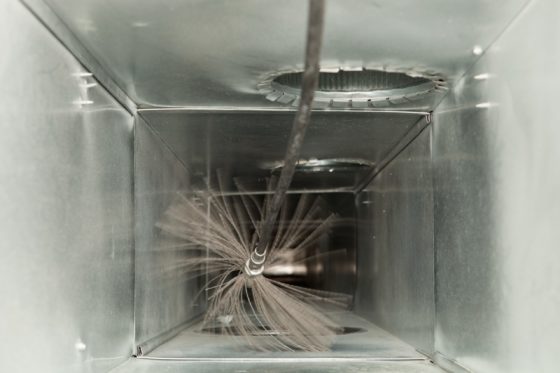
It may be surprising to learn that the air quality inside the average house is far worse and more polluted than outside the home. This is true at any time of the year, but the problem typically becomes even worse during the winter when most people tend to have their homes closed uptight. The good news is that there are a number of fairly simple steps you can take to ensure you can breathe easily and don’t have to suffer from poor air quality this winter.
1. Make Sure Your HVAC System Is Professionally Maintained
Routine maintenance of your home’s heating and cooling system is essential for many reasons. Not only does keeping your HVAC professionally maintained ensure it functions as efficiently as possible, but it can also improve your indoor air quality by helping to minimize the number of pollutants and other contaminants that circulate throughout the home.
In addition to professional maintenance, it’s also important to check the condition of your HVAC air filter every month or so. The air filter is designed to trap dirt, dust, pollen and other allergens and pollutants to ensure they aren’t spread throughout the home. However, this simply isn’t possible if the air filter is dirty or becomes clogged. Therefore, you’ll want to make sure your air filter is clean and in good condition. If the filter looks overly dirty, it’s time to either clean or replace it.
2. Check That Your Ducts Are Clean and Properly Sealed
Dirt and dust naturally begin to collect inside your home’s ductwork over time. As a result, these allergens and pollutants are then spread throughout the house whenever the blower on your HVAC system runs. This is why most HVAC experts recommend having your ducts professionally cleaned every three to five years.
Although ductwork collects dust naturally, the problem tends to get much worse if the ducts are leaking, damaged or improperly sealed. Any leaks or holes in the duct allow for more contaminants to get inside the ductwork. Not only that, but leaks can also cause condensation to form inside the ducts. When this happens, it can create the perfect conditions for mold to begin forming. These dusty, moist conditions can also create the ideal habitat for crickets, cockroaches, mice and other pests to begin living and breeding inside your ducts.
Having your ducts professionally cleaned can eliminate any mold, pests and other allergens and pollutants to ensure they don’t negatively impact your home’s air quality. However, these problems can quickly come back if the ducts are damaged or poorly sealed. For this reason, it’s also a good idea to have your ductwork inspected and sealed or repaired as needed.
3. Manage Your Home’s Humidity Level
Excessively dry air can be a huge problem during the winter. The humidity level is naturally much lower during the colder winter months, and this dry air can cause or worsen many respiratory problems and other health issues. Breathing in overly dry air irritates your throat and sinuses, which can trigger nosebleeds, asthma attacks and coughing fits. This is part of the reason why many doctors recommend using a humidifier during the winter if you’re suffering from a cold, asthma or other respiratory issues. Low humidity levels can also just make your home less comfortable and lead to dry, itchy skin and red, itchy eyes. If you suffer from any of these issues, installing a whole-home humidifier is a great way to fight them by ensuring your home’s humidity remains at a comfortable level.
Although it usually isn’t as big of a problem during the winter, excess humidity can also worsen allergy issues and lead to numerous other problems. High humidity levels create the perfect moist conditions for mold growth, which has the potential to be toxic to your health. Therefore, if your home is overly moist and humid, you might consider a whole-home dehumidifier instead.
The optimal indoor humidity level is somewhere between 30% and 50%. Humidifiers are a good choice if the humidity level is below 30 percent. On the other hand, a dehumidifier is useful in situations where the humidity level is over 50% to 60%.
4. Consider a Whole-Home Air Filtration System
Although your HVAC air filter works to filter out some dust and other allergens, it can’t remove most other pollutants from the air. This is especially true of volatile organic compounds (VOCs) and other chemical irritants, all of which can lead to numerous health problems. Smoke from cooking, chemical cleaning products and even your home’s furnishings and building materials can all give off VOCs and other harmful chemicals. Using an air purifier or installing a whole-home air filtration system is the best way to eliminate these chemicals and improve your indoor air quality. Not only that, but these systems can also eliminate odors to keep your home smelling fresh and clean.
5. Let Your House Air Out Occasionally
Another simple way to improve your home’s air quality is to simply open up your doors and windows occasionally to let your house air out. Getting a draft going through the house allows all that stale, polluted air to escape and be replaced by fresh, cleaner air. For best results, you should do this once every week or so if possible.
6. Keep Your House Clean
Keeping your home clean and free of dust can also help to improve air quality. Mopping your floors and vacuuming your carpets helps to remove dirt, pet hair and dander, pollen and other allergens that could otherwise contribute to poor indoor air quality. If possible, you should use a vacuum with a HEPA filter to more effectively remove these allergens and pollutants. As well, you should also pay special attention to which cleaning products you use since many chemical cleaning agents can release VOCs and other irritants. To avoid this, it’s best to use natural or chemical-free cleaning products as much as possible.
7. Use Plants to Help Purify Your Air
Plants have been scientifically proven to help purify the air and filter out carbon dioxide, VOCs and other pollutants. Simply investing in a few houseplants can provide major benefits by providing a good source of clean oxygen and purifying the air. Although plants aren’t nearly as effective as an air purifier or filtration system, they can definitely still help.
8. Have Your Air Quality Tested
All of the above methods can be hugely beneficial for improving your home’s air quality. However, the only real way to know what potential air quality issues you may be facing is to have your home’s air tested. Professional air quality testing from a reputable HVAC company can identify mold spores, chemical compounds, humidity issues and any other problems that could be negatively affecting your air quality. In this way, you can get a better understanding of any issues you’re facing and how to best combat them.
Your Indoor Air Quality Experts
At Gallagher's Plumbing, Heating and Air Conditioning, we offer a wide range of solutions that can help you to improve your home’s indoor air quality. We can assist you with air quality testing. We also specialize in air filtration systems, humidifiers and dehumidifiers, duct cleaning and more. As a full-service HVAC company, we also offer heating and cooling system maintenance, repair and installation services. Our team consists of licensed, highly trained plumbers to assist with any water heater issues or water purification needs.
Interesting in learning more about how we can help improve the air quality in your Sacramento, Los Molinos or Olivehurst home? Contact Gallagher's Plumbing, Heating and Air Conditioning today.

